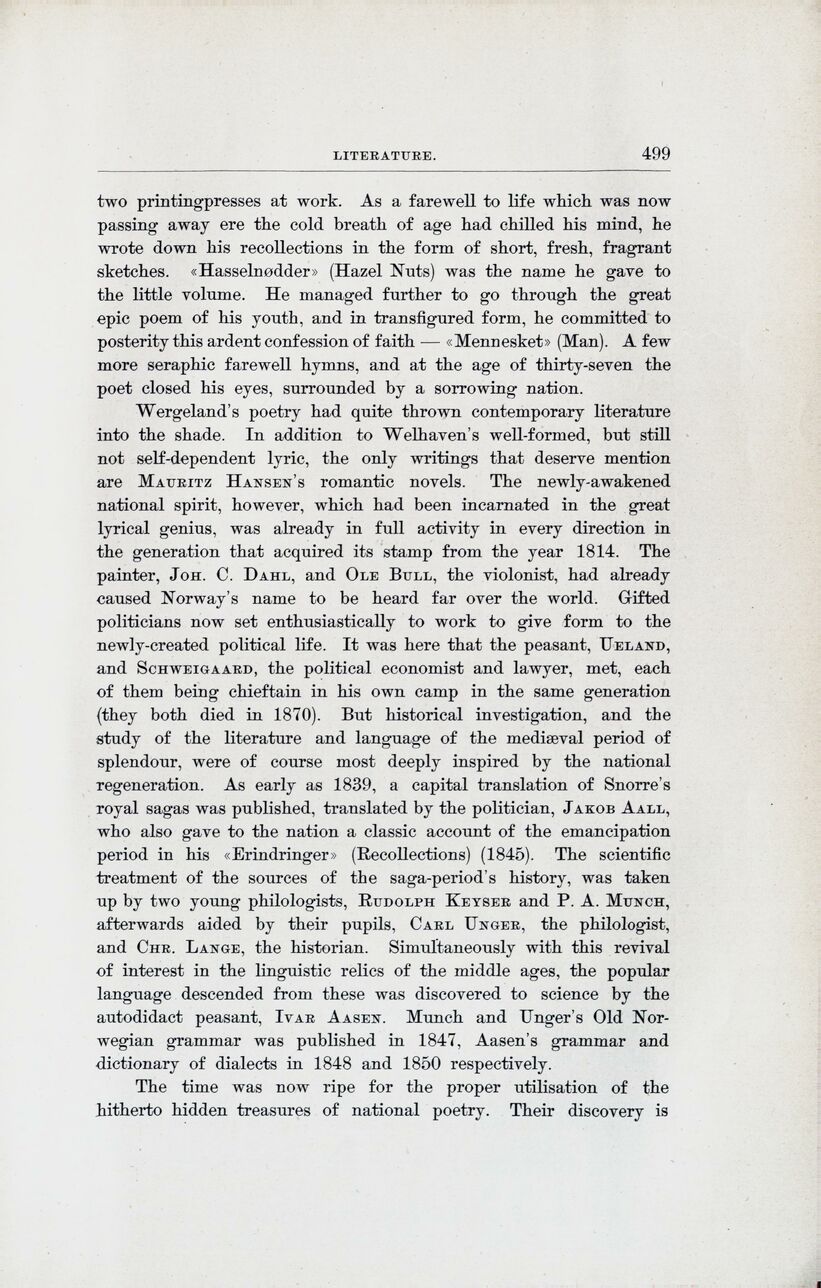
Full resolution (JPEG) - On this page / på denna sida - Literature, by Chr. Brinchmann

<< prev. page << föreg. sida << >> nästa sida >> next page >>
Below is the raw OCR text
from the above scanned image.
Do you see an error? Proofread the page now!
Här nedan syns maskintolkade texten från faksimilbilden ovan.
Ser du något fel? Korrekturläs sidan nu!
This page has been proofread at least once.
(diff)
(history)
Denna sida har korrekturlästs minst en gång.
(skillnad)
(historik)
two printingpresses [[** sic, intet bindestrek]] at work. As a farewell to life which was now
passing away ere the cold breath of age had chilled his mind, he
wrote down his recollections in the form of short, fresh, fragrant
sketches. «Hasselnødder» (Hazel Nuts) was the name he gave to
the little volume. He managed further to go through the great
epic poem of his youth, and in transfigured form, he committed to
posterity this ardent confession of faith — «Mennesket» (Man). A few
more seraphic farewell hymns, and at the age of thirty-seven the
poet closed his eyes, surrounded by a sorrowing nation.
Wergeland’s poetry had quite thrown contemporary literature
into the shade. In addition to Welhaven’s well-formed, but still
not self-dependent lyric, the only writings that deserve mention
are Mauritz Hansen’s romantic novels. The newly-awakened
national spirit, however, which had been incarnated in the great
lyrical genius, was already in full activity in every direction in
the generation that acquired its stamp from the year 1814. The
painter, Joh. C. Dahl, and Ole Bull, the violonist, [[** sic]] had already
caused Norway’s name to be heard far over the world. Gifted
politicians now set enthusiastically to work to give form to the
newly-created political life. It was here that the peasant, Ueland,
and Schweigaard, the political economist and lawyer, met, each
of them being chieftain in his own camp in the same generation
(they both died in 1870). But historical investigation, and the
study of the literature and language of the mediæval period of
splendour, were of course most deeply inspired by the national
regeneration. As early as 1839, a capital translation of Snorre’s
royal sagas was published, translated by the politician, Jakob Aall,
who also gave to the nation a classic account of the emancipation
period in his «Erindringer» (Recollections) (1845). The scientific
treatment of the sources of the saga-period’s history, was taken
up by two young philologists, Rudolph Keyser and P. A. Munch,
afterwards aided by their pupils, Carl Unger, the philologist,
and Chr. Lange, the historian. Simultaneously with this revival
of interest in the linguistic relics of the middle ages, the popular
language descended from these was discovered to science by the
autodidact peasant, Ivar Aasen. Munch and Unger’s Old
Norwegian grammar was published in 1847, Aasen’s grammar and
dictionary of dialects in 1848 and 1850 respectively.
The time was now ripe for the proper utilisation of the
hitherto hidden treasures of national poetry. Their discovery is
<< prev. page << föreg. sida << >> nästa sida >> next page >>